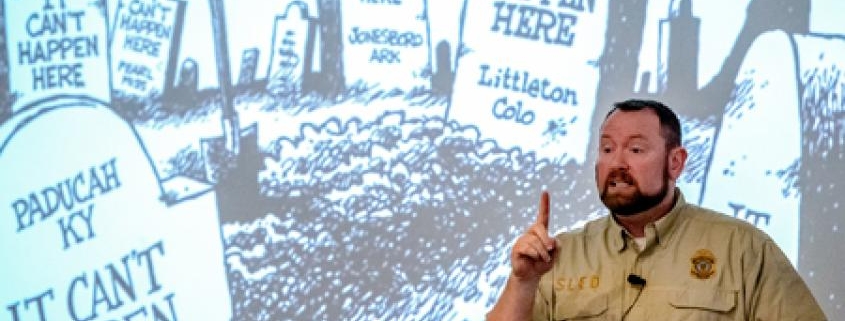WAW Sponsored a Seminar on Active Shooters In the Workplace
‘Every Employer Has A Duty’ – Police Official Presents Talk On Active Shooters
Daily News-Record – January 20, 2016 ~ By Vic Bradshaw
Photo by: Austin Bachand / DN-R
Americans, Wayne Freeman said Tuesday, should prepare themselves for the possibility that someone will enter their workplace intent on killing people, because active-shooter incidents are on the rise.
“These are getting worse,” the South Carolina Law Enforcement Division special agent told a crowd of about 100 local law enforcement and business professionals at Blue Ridge Community College’s Robert E. Plecker Workforce Center. “They’re going to get worse. They’re going to get much worse. … Paris is a drop in the bucket. Paris is a warm-day picnic.”
Between 1965 and 2000, he said, the number of workplace active-shooter incidents in the United States totaled 100. In the last 15 years, the total is 210.
Canada is second in active-shooter incidents over the last 50 years with a total of nine.
Thomas Ullrich, who specializes in U.S. Occupational Safety and Health Administration issues for Wharton Aldhizer & Weaver, said the Harrisonburg law firm brought Freeman to speak to invited guests because OSHA is placing more emphasis on violence in the workplace.
“Every employer has a duty,” Ullrich said, “to take action to minimize workplace violence.”
People might feel safe in this community, but he noted that workplace violence has happened in the Valley. Two people were shot by a man who committed suicide at American Home-Patient in Harrisonburg in May 2006, and a man was shot and killed at F.R. Drake Co. in Waynesboro in February 2014 by a man who turned himself into police.
Combat Scenario
Active-shooter incidents are more lethal than actual military combat, Freeman said, because soldiers have combat training. Most people in the workplace don’t.
“An active shooter,” he said, “is combat.”
Prevention, of course, is the preferred way to deal with such issues. Freeman said anyone who feels unsafe at their job should take their concerns to human resources.
As a rule, he said, shooters can’t be talked down. He’s heard of people trying to reason with them, only to be shot.
So, it’s imperative that people try to stay safe as long as possible — hopefully at least the three minutes it takes the average police department to respond to a call. Freeman said the average active-shooter incident lasts 12 minutes.
He said the top priority for police responding to a call is to save as many people as possible.
“We’re not there to help the wounded,” he said. “We’re there to stop the shooter.”
What To Do
In an active-shooter situation, Freeman said questioning or denying what’s going on could be deadly. The sooner reality is accepted, the quicker a person can take steps to save his life.
A person should call 911 as soon as he realizes he’s in danger so police can be sent to the scene, Freeman said.
If people can escape safely, he said they should flee without delay or hesitation. If they can’t, they should protect themselves by locking the shooter out of the room they’re in and placing barriers in front of the door.
“You want to create as many time barriers as you can,” he said. “The more time you can take away from that shooter, the closer [law enforcement] can get.”
If an officer bursts into a room, he advised that people fall facedown on the floor, cover their head with their hands and stay calm and quiet.
A person should charge the shooter only if it’s necessary to defend himself, Freeman said.
When fleeing workplace violence, he said people should have nothing in their hands and keep them visible. That way, officers won’t mistake them for an attacker.
Employers, Freeman said, should prepare for an active-shooter situation by establishing a site for a command post and interior and exterior patient-care locations; making plans for triage and transport to an alternate location; determining separate staging areas for first responders and the media; and establishing a spot for reunification of survivors with families.
Susan Grossman, human resources generalist for Truck Enterprises Inc., said her company has a workplace violence policy, and employees have received basic training about whether to run, hide or fight.
“I’d like to take it to the next level,” she said.


